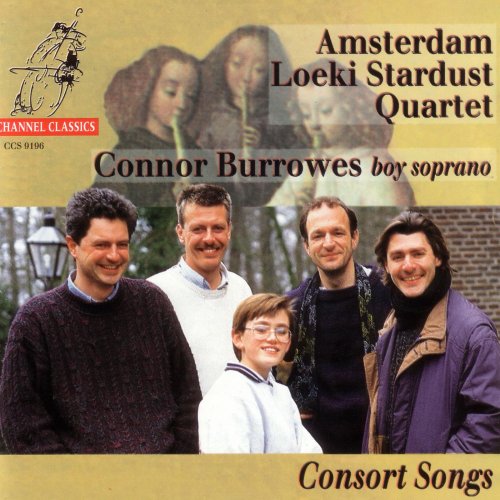
Amsterdam Loeki Stardust Quartet - Consort Songs (1996)
BAND/ARTIST: Amsterdam Loeki Stardust Quartet, Connor Burrowes
- Title: Consort Songs
- Year Of Release: 1996
- Label: Channel Classics Records
- Genre: Classical
- Quality: FLAC (tracks + booklet)
- Total Time: 50:50
- Total Size: 226 MB
- WebSite: Album Preview
Tracklist:
1. Amsterdam Loeki Stardust Quartet – Sorrow, Come (05:34)
2. Amsterdam Loeki Stardust Quartet – Courant (01:30)
3. Amsterdam Loeki Stardust Quartet – Wretched Albinus (02:30)
4. Amsterdam Loeki Stardust Quartet – With Lilies White (02:38)
5. Amsterdam Loeki Stardust Quartet – Aria (02:43)
6. Amsterdam Loeki Stardust Quartet – Complain With Tears (02:14)
7. Amsterdam Loeki Stardust Quartet – When Shall My Sorrowful Sighing (02:05)
8. Amsterdam Loeki Stardust Quartet – In a Merry May Morn (01:27)
9. Amsterdam Loeki Stardust Quartet – When May Is In His Prime (02:10)
10. Amsterdam Loeki Stardust Quartet – from Taffel-Consort: Male-Content (01:01)
11. Amsterdam Loeki Stardust Quartet – This Merry Pleasant Spring (01:37)
12. Amsterdam Loeki Stardust Quartet – Ye Mortal Wights (04:50)
13. Amsterdam Loeki Stardust Quartet – from Taffel-Consort: Paduan (03:24)
14. Amsterdam Loeki Stardust Quartet – from Taffel-Consort: Volta (01:00)
15. Amsterdam Loeki Stardust Quartet – Like As the Day (02:55)
16. Amsterdam Loeki Stardust Quartet – from the Paradise of Dainty Devices: How Can the Tree (03:10)
17. Amsterdam Loeki Stardust Quartet – Fantasia VII (06:23)
18. Amsterdam Loeki Stardust Quartet – Four-note Pavan (03:31)
1. Amsterdam Loeki Stardust Quartet – Sorrow, Come (05:34)
2. Amsterdam Loeki Stardust Quartet – Courant (01:30)
3. Amsterdam Loeki Stardust Quartet – Wretched Albinus (02:30)
4. Amsterdam Loeki Stardust Quartet – With Lilies White (02:38)
5. Amsterdam Loeki Stardust Quartet – Aria (02:43)
6. Amsterdam Loeki Stardust Quartet – Complain With Tears (02:14)
7. Amsterdam Loeki Stardust Quartet – When Shall My Sorrowful Sighing (02:05)
8. Amsterdam Loeki Stardust Quartet – In a Merry May Morn (01:27)
9. Amsterdam Loeki Stardust Quartet – When May Is In His Prime (02:10)
10. Amsterdam Loeki Stardust Quartet – from Taffel-Consort: Male-Content (01:01)
11. Amsterdam Loeki Stardust Quartet – This Merry Pleasant Spring (01:37)
12. Amsterdam Loeki Stardust Quartet – Ye Mortal Wights (04:50)
13. Amsterdam Loeki Stardust Quartet – from Taffel-Consort: Paduan (03:24)
14. Amsterdam Loeki Stardust Quartet – from Taffel-Consort: Volta (01:00)
15. Amsterdam Loeki Stardust Quartet – Like As the Day (02:55)
16. Amsterdam Loeki Stardust Quartet – from the Paradise of Dainty Devices: How Can the Tree (03:10)
17. Amsterdam Loeki Stardust Quartet – Fantasia VII (06:23)
18. Amsterdam Loeki Stardust Quartet – Four-note Pavan (03:31)
Consort Songs Teares or Lamentacions of a sorrowfull Soule is the publication where Sir William Leighton uses the term consort song for the first time. During the reign of Queen Elizabeth, the genre of the consort song already appeared in certain collections from the 1580s, which contain several examples of a song-form for a high solo voice accompanied by four instruments. A few early four-part consort songs survive, but five-part texture seems to have become standard almost from the inception of this form. The consort song emerged from the assimilation and expansion of the English ayre and the highly popular Italian madrigale. To the simpler and ingratiating manner of the lute ayre, a more contrapuntal and expressive style of the madrigal was added. The musical importance of the consort song rests largely upon its development by the composer William Byrd, who regarded it as the standard means of setting vernacular poetry. In his songs almost every vocal phrase is anticipated, supported and imitated by a dense stream of notes that flows round it. Although Byrd presented most items in his published collections as fully vocal compositions, about half of them are in fact consort songs, which Byrd stated as being originally made for instruments to express the harmony, and one voice to pronounce the ditty. There will always remain an attractive amount of uncertainty when trying to reveal the beauty of a composition in all its colours. Searching for a favourable lighting means experimenting with historic tone colours and adding or omitting elements. Both the recorder and the soprano voice of a boy are known to have been established during the time of publication of consort songs, and the vocal part always lies within the range of a boys voice, either treble or mean (alto). Naturally these songs have had performances in more than one appropriate rendering, according to availability of different voices and instruments.
As a ISRA.CLOUD's PREMIUM member you will have the following benefits:
- Unlimited high speed downloads
- Download directly without waiting time
- Unlimited parallel downloads
- Support for download accelerators
- No advertising
- Resume broken downloads


